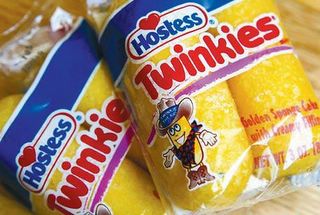
By Candy Sagon
The Washington Post
C'mon, admit it. You eat Twinkies. You love 'em.
Maybe you feel a little guilty about it, but you're not alone. Americans spent $47 million on them in the past year.
That's right. The junk food we love to ridicule.
And yet despite it all, Hostess makes 500 million of them every year. And sales are increasing, according to Information Resources, a Chicago firm that tracks retail sales and trends.
This year the little cream-filled, yellow spongecake celebrates its 75th birthday — and no, it's not because the same ones have been on the shelf for that long. That's just one of the urban myths surrounding the snack cakes that were invented in 1930.
Back then, James Dewar, manager of Chicago's Continental Bakery, wanted to find another use for his company's shortcake pans. He decided to fill the small, oblong cakes with a banana-cream filling and name them after the "Twinkle Toe" shoes he saw advertised on a billboard in St. Louis. Banana-cream-filled Twinkies, selling two for a nickel, debuted as part of the Hostess baked-goods line. During World War II, when there was a banana shortage, the filling flavor changed to vanilla.
By the 1950s, Twinkies had become a school lunchbox staple. In 1999, President Clinton and the White House Millennium Council selected the Twinkie to be preserved in the nation's millennium time capsule, calling it an enduring American icon.
Nutritionists scoff at them for being fatty and sugary, but that doesn't keep Hostess from turning out about 1,000 per minute. And just in case you wondered exactly how that happens, the cakes are baked for 10 minutes, then the cream filling is injected through three holes in the top, which is browned from baking. The cake is flipped before packaging, so the rounded yellow bottom becomes the top.
The Twinkie factory is still in Chicago, which also happens to be the American city with the highest per capita consumption of Twinkies. Chicagoans can go to comfort-food restaurant Kitsch'n for Twinkie Tiramisu. Or Swank Frank, which sells those state-fair favorites, deep-fried Twinkies.
The cakes' sturdiness and longevity have led to the myth, say Hostess officials, that Twinkies have a shelf life measured in years, even decades.
In reality, Twinkies' shelf life is more like 25 days, says Theresa Cogswell, who calls herself the Twinkie guru and is vice president for research and development at Interstate Bakeries, the parent company of Hostess.
Still, a 25-day shelf life is pretty long. Twinkies are basically flour, sugar (three kinds of it), oil, eggs and chemicals (mainly preservatives and stabilizers). They're 150 calories each, about a third of that from fat. Cogswell doesn't think that's so bad. "There's no bad foods — just bad quantities," she says.
Lewis Browning, a retired milk-truck driver, has been eating one or two Twinkies a day for 64 years. "Had one for breakfast this morning with a banana and a glass of milk," he says from his home south of Indianapolis. The 22,000 he's eaten have earned him an appearance on "The Tonight Show With Jay Leno" and a lifetime supply of Twinkies from Hostess.
Others save their Twinkies for special occasions. Like weddings. Philip Delaplane, 50, a chef and instructor at the Culinary Institute of America in New York, says he's loved Twinkies since he was a child. So does his wife, Pam. For their wedding last year, Delaplane built a four-tier wedding cake out of Twinkies and other Hostess snack cakes. "We didn't want anything too stuffy. We wanted something fun," he says.
Although he had back-up desserts in case guests balked at eating junk food, he needn't have worried. "They devoured the cake," he says. "I had used toothpicks to attach the snack cakes to Styrofoam forms and they just yanked them all out. It was the talk of the wedding."
While people like Delaplane maintain a nostalgia for the Twinkies of their youth, the snack cake has been linked to several not-so-sweet events.
When Minneapolis City Council candidate George Belair served Twinkies and other refreshments to two senior citizens' groups in 1985, he was indicted for bribery in what the newspapers dubbed "Twinkiegate." Although the charges were eventually dropped, the case led to a Minnesota fair campaign act, popularly known as the "Twinkie law." The law was repealed in 1988.
And, of course, there's the famed courtroom defense in the 1979 trial of former San Francisco supervisor Dan White, accused of shooting the city's mayor and another supervisor. White's attorneys argued that he suffered from severe depression that had been exacerbated by junk food bingeing. Although Twinkies were only mentioned in passing, the term "Twinkie Defense" was quickly coined by journalists to explain the legal strategy that led to White's conviction on a lesser charge.
Having a product linked to such dubious outcomes might upset some companies, but Hostess officials seem unperturbed. "[Twinkies] are a constant in your life. They always come back around," says Cogswell, who has worked for Hostess for 20 years. "The way we look at it, sometimes you just need a sugar fix."
No comments:
Post a Comment